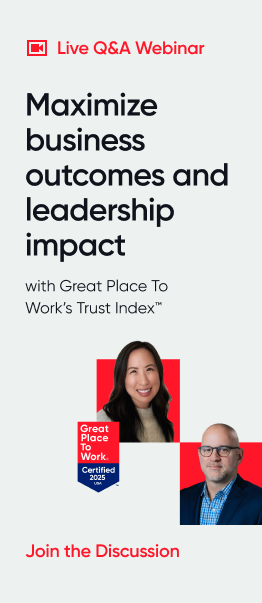Benchmarks & Trends, Elements of Company Culture, Employee Experience, High-trust leadership
The three essential elements that all great workplaces have.
You might have several theories about what makes an organization a positive place to work.
Happy employees are surely those with inflated paychecks and unmatched benefit programs. Perhaps they get a share of company profits in employee stock ownership plans, or have ditched traditional hierarchy for a more equitable “flat” structure.
You’d be wrong.Trust in the workplace
The employee experience isn’t fundamentally determined by whether a company is privately owned or publicly traded, whether its workers are hourly or salaried, or whether a company writes software in Silicon Valley or manufactures automobiles in Michigan.
The key ingredient is deceptively simple: trust. Do your workers trust you?
Discovering the magic ingredient was the result of thousands of hours of interviews and focus groups conducted by the founders of Great Place To Work® in developing its Trust Index™.
“For pretty much every theory we had, we found consistent exceptions,” says Sarah Lewis-Kulin, vice president of global recognition at Great Place To Work. “What we didn’t find an exception for was trust.”
The Great Place To Work Model

What builds trust in the workplace?
Trust can feel like a squishy word, even as it becomes more and more recognized as an essential business asset. Edelman’s annual Trust Barometer shows the way trust in institutions like the media and government can have profound implications for markets.
But what does it mean for employees to experience trust? Telling them to trust you doesn’t work. You have to build a high-trust culture over time.
According to Great Place To Work research, such a culture is built on three components:
- Credibility. Do workers believe leaders are competent, communicative, and honest?
- Respect. Do workers feel respected both as professionals and individuals with lives outside of work?
- Fairness. Do workers see the organization as a place where everyone has a fair chance to succeed?
“What we're really talking about is that everyone in the organization is treated with credibility, respect, and fairness … regardless of their job role, their gender, any race, ethnicity, or other demographic category,” says Lewis-Kulin.
For a workplace to be great, the employee experience has to be consistent for everyone. If only senior-level, male managers say they trust the organization while front-line employees or women in management are having a very different experience, that won’t build trust.
That’s why Great Place To Work introduced its For All™ model, where gaps between different employee groups are measured to identify how every employee feels at work — not just the majority.
The building blocks of trust in the workplace
How do great leaders cultivate credibility, respect, and fairness within their companies? Closing the “say-do gap” is crucial, as trust only develops when words are followed by action.
For any culture to develop high levels of trust, it has to start with leaders.
“You can't create a trusting organization without it being modeled as a value from the top of the organization,” Lewis-Kulin says. Otherwise, you might have a pocket of employees who trust each other, but they get their backs up when working with people outside their team.
Machiavelli might approve, but it’s no recipe for success in the modern workplace.
Here are some ways for leaders to start building trust:
Credibility
- Communicate consistently and directly.
- Ensure your public actions mirror the values you subscribe to internally. If your PR team, for instance, publicly proclaims that your company champions DEIB, but employees aren’t experiencing an inclusive culture, they’ll view your actions as hypocritical.
- Demand that public value statements match the internal experience of employees.
- Make sure that communication goes both ways— listen to your people as much as you share information with them.
- Take tangible actions every time you ask and receive employee feedback.
Respect
- Create a culture that supports employees’ work-life balance, allows them to use PTO and flexible schedules offered, and acknowledges their lives outside of work. And don’t forget to set a good example yourself.
- Show genuine interest in who your people are and what matters to them outside of work.
- Show appreciation for employees’ good work and extra effort.
- Provide development and training programs, give employees time to do them, and reward employees who complete them.
- Ensure everyone can bring their full selves to the workplace by focusing on belonging and inclusion.
Fairness
- Review compensation and close any pay gaps for employees doing equal work.
- Add seats to the board of directors to ensure marginalized voices are heard.
- Analyze workplace well-being programs to ensure they serve the needs of all employees.
7 ways to build trust in the workplace
Once your organization is committed to building trust, your leaders must develop an action plan to transform your culture. A great place to start is with the Great Place To Work Trust Index, which provides unmatched insight into the experiences of your workforce. Based on your data, you might consider focusing on one of the nine high-trust leadership behaviors that our research shows make the biggest difference in building trust.
Here are seven ideas for applying those principles to your workplace:
1. Make sure every employee has the chance to share their feedback with leaders
Listening is the foundation of all the high-trust leadership behaviors. Poor listening is one of the most likely culprits for a breakdown in trust, and the best organizations go to great lengths to ensure every employee’s voice is heard.
Employee surveys are a great place to start, but the best companies also host listening sessions with top leaders, engage with employee resource groups (ERGs), and even make employee listening a dedicated job within the HR function.
Top tip: Consider how different job roles in the organization experience communication from leaders. Can you bring frontline teams off the floor to participate in a brainstorming session with your leaders? Is there a team that never meets with the C-suite? The best companies find ways to make sure every employee, regardless of role or job level, has a chance to share their ideas.
2. Find ways for every employee to be recognized for their contributions to the organization
Thanking employees for their unique contributions is a crucial way to build trust. The best companies don’t just recognize one employee of the month. They ensure every employee is visibly recognized and celebrated even when a project ends in failure.
To do this right, leaders must get to know their employees on a personal level. What are their unique passions and talents? What are their career goals? The best expressions of gratitude are personalized to the recipient and are a consistent affirmation of their value to the business.
Top tip: Connect recognition programs to specific examples of how employees can live the values of the organization. Use recognition to connect employees with your mission, and help them find meaning in their work.
3. Provide training and development opportunities that help employees build meaningful careers
Employees expect to have opportunities to learn and grow at work. Nine in 10 (91%) respondents to the 2023 Work In America Survey from the American Psychological Association said it was very or somewhat important to them to have consistent opportunities to learn.
Helping employees learn new skills and develop their careers is a powerful way to build trust and boost business performance. The best leaders are mentors and coaches, finding ways to open doors and challenge their direct reports with new projects and opportunities.
Top tip: Identify employees by their skills, not their credentials or education. Companies can create libraries of skills and use technology to match employees with those skills to open projects and roles within the organization.
4. Prioritize employee well-being with investments in flexibility and health programs
Employee well-being has declined to pre-pandemic levels. Great workplaces are responding to this trend with increased benefits and renewed commitments to flexibility and balance. When leaders demonstrate care for their workers, they focus on creating inclusive and welcoming environments. They ask about the individual needs of employees and launch programs to cover gaps that are causing unnecessary stress.
Top tip: Consider how your workplace can address external factors that are causing problems for your workforce. Can you invest in the community, sponsor child care services, or promote a healthier environment near where your employees live?
5. Go beyond compensation to ensure every employee gets a fair share of the rewards for business success
Fair pay is an important place to start, but compensation is not the only reward that employees value from their work. Recognition, learning and growth opportunities, and charitable activity can also be highly valuable to employees and can create a sense of unfairness when some employees are left out.
Great leaders make sure every employee can share in the benefits of working for a successful business. That means ensuring employees have equal access to information and roles that are structured to allow them to participate in the full range of company activities, from social gatherings to charitable events.
Top tip: When considering fairness, make sure you are measuring the right metrics that capture the full experience of employees. Invisible dynamics in your organization might be creating an unfair system, and correcting measurement mistakes is the first step to fixing those issues.
6. Make sure new employees receive a warm welcome when joining the organization
You never get a second chance to make a first impression. Onboarding is a crucial part of the employee experience, and poor execution can dramatically impact trust for new employees.
This starts with the recruiting process, where experiences with hiring managers can set expectations and send important signals about how welcome a new employee is to bring their authentic self to the organization.
Top tip: Go beyond the handbook for orientation. Send new hires a welcome note and start getting them integrated into your culture before their first day. Pair new hires with a buddy other than their direct manager, and find ways to connect new hires immediately with important groups in the company, such as ERGs.
7. Connect every employee to your purpose as an organization
Meaningful work is a crucial driver of the employee experience and makes a big difference in how likely you are to want to stay with your company long-term.
The best companies make sure that every company has the opportunity to experience the impact of their work on the world, whether that is meeting with a customer or testing a new product. This sense of purpose then contributes to the pride employees feel in their workplace.
Top tip: Engage frontline managers early and often to ensure they are helping their teams connect to the big picture. When frontline managers are not clear about the direction and mission for the company, the business is less likely to experience the benefits of being a purpose-driven workplace.
The business case for trust
The good news for leaders is that building trust has an unmistakable impact on financial performance for organizations across industries.
According to independent investment firm FTSE Russell, cumulative stock market returns outpace the market by a factor of three for publicly held organizations on the Fortune 100 Best Companies to Work For® List.
The data is clear: Companies that invest in their workers deliver stronger financial results over the long term. Even better, those companies have the resilience to ride out economic downturns. Great Place To Work research shows that companies that supported key employee groups were able to grow during the Great Recession from 2008 to 2010, and have vastly outstripped the competition in the decade since.
The outcomes of employee trust on the bottom line are undeniable:
- High-trust cultures have half the attrition turnover of industry competitors
- High-trust cultures have accelerated rates of innovation
- High-trust cultures see more employees go above and beyond to deliver for clients and customers
Take your first step towards a healthier company culture with Great Place To Work’s research-backed engagement survey.
Transform culture into business success
Let our Great Place To Work® Model guide your culture to drive performance. Start your journey with Great Place To Work today.











